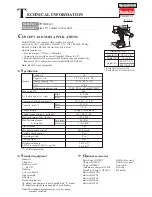
7 ENGLISH
NOTE:
When the tool is overheated, the tool stops
automatically and the lamp starts flashing. In this
case, release the switch trigger. The lamp turns off in
one minute.
NOTE:
Use a dry cloth to wipe the dirt off the lens of
the lamp. Be careful not to scratch the lens of lamp, or
it may lower the illumination.
Reversing switch action
►
Fig.6:
1.
Reversing switch lever
CAUTION:
Always check the direction of
rotation before operation.
CAUTION:
Use the reversing switch only after
the tool comes to a complete stop.
Changing the
direction of rotation before the tool stops may dam
-
age the tool.
CAUTION:
When not operating the tool,
always set the reversing switch lever to the neu-
tral position.
This tool has a reversing switch to change the direction
of rotation. Depress the reversing switch lever from the
A side for clockwise rotation or from the B side for coun
-
terclockwise rotation.
When the reversing switch lever is in the neutral posi-
tion, the switch trigger cannot be pulled.
Speed change
►
Fig.7:
1.
Speed change lever
CAUTION:
Always set the speed change lever
fully to the correct position.
If you operate the
tool with the speed change lever positioned halfway
between the "1" side and "2" side, the tool may be
damaged.
CAUTION:
Do not use the speed change lever
while the tool is running.
The tool may be damaged.
Displayed
Number
Speed
Torque
Applicable
operation
1
Low
High
Heavy load-
ing operation
2
High
Low
Light loading
operation
To change the speed, switch off the tool first. Push
the speed change lever to display "2" for high speed
or "1" for low speed but high torque. Be sure that the
speed change lever is set to the correct position before
operation.
If the tool speed is coming down extremely during the
operation with display "2", push the lever to display "1"
and restart the operation.
Selecting the action mode
CAUTION:
Always set the ring correctly to
your desired mode mark. If you operate the tool
with the ring positioned halfway between the
mode marks, the tool may be damaged.
CAUTION:
When you change the position
from "
" to other modes, it may be a little dif-
ficulty to slide the action mode changing ring. In
this case, switch on and run the tool for a second
at the "
" position, then stop the tool and slide
the ring to your desired position.
►
Fig.8:
1.
Action mode changing ring
2.
Adjusting
ring
3.
Graduation
4.
Arrow
This tool has three action modes.
•
Drilling mode (rotation only)
•
Hammer drilling mode (rotation with
hammering)
•
Screwdriving mode (rotation with clutch)
Select one mode suitable for your work. Turn the
action mode changing ring and align the mark that you
selected with the arrow on the tool body.
Adjusting the fastening torque
►
Fig.9:
1.
Action mode changing ring
2.
Adjusting
ring
3.
Graduation
4.
Arrow
The fastening torque can be adjusted in 20 levels by turning the adjusting ring. Align the graduations with the arrow
on the tool body. You can get the minimum fastening torque at 1 and maximum torque at 20.
Before actual operation, drive a trial screw into your material or a piece of duplicate material to determine which
torque level is required for a particular application. The following shows the rough guide of the relationship between
the screw size and graduation.
Graduation
1
2
3
4
5
6
7
8
9
10 11 12 13 14 15 16 17 18 19 20
Machine screw
M4
M5
M6
Wood
screw
Soft wood
(e.g. pine)
–
ɸ
3.5 x 22
ɸ
4.1x 38
–
Hard wood
(e.g. lauan)
–
ɸ
3.5 x 22
ɸ
4.1x 38
–
Содержание DHP483
Страница 2: ...1 2 3 Fig 1 1 2 Fig 2 1 Fig 3 1 Fig 4 1 Fig 5 1 A B Fig 6 1 Fig 7 1 2 4 3 Fig 8 2 ...
Страница 3: ...1 2 4 3 Fig 9 1 3 2 Fig 10 1 3 2 Fig 11 1 2 Fig 12 Fig 13 1 Fig 14 Fig 15 3 ...
Страница 71: ...71 ...
Страница 74: ...1 2 3 Fig 1 1 2 Fig 2 1 Fig 3 1 Fig 4 1 Fig 5 1 Fig 6 1 A B Fig 7 4 1 2 3 5 Fig 8 2 ...
Страница 75: ...Fig 9 1 2 Fig 10 1 3 2 Fig 11 3 2 1 Fig 12 Fig 13 3 ...
Страница 142: ...70 ...
Страница 143: ...71 ...








































